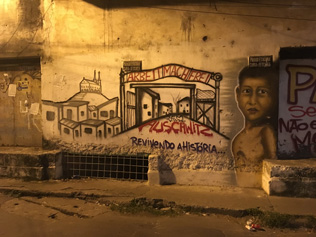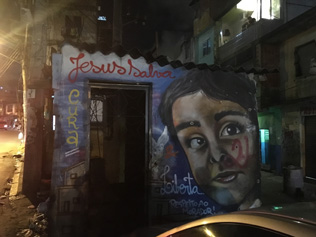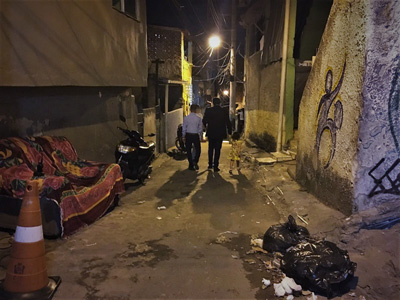Beyond the mega-church: scenes from urban Rio de Janeiro at the intersection of religion and violence
My field research investigated the role of Christian activism in the making of the ethical subject, asking how the ethical and political lives of Christians are imagined, lived, and intertwined. I carried out fieldwork amongst Pentecostal Christians of a mega-church in Rio de Janeiro, Brazil. What I have learnt throughout my time amongst these believers is that ethics and politics are intermingled in various ways, especially through values, discourses, and practices that orient these Christians towards what they call “building the Kingdom of God on Earth”. Core to the concept of “building the Kingdom” are practices of Christian activism that are aimed to transform society according to Christian values. However, in a metropolis like Rio, which has suffered from state corruption and unprecedented waves of violence, “building the Kingdom” is no easy task.How then do these Christians “build the Kingdom” amidst such a precarious situation?The images show the interaction between Christianity, the precarious life of the favelaand the extent to which commitment to “building the Kingdom” is practiced by prioritizing – as they put it – “the work of God” over the risks to one’s self and one’s own family.
Disclosure:
*In order to protect the identity of the informants, I have omitted the name of the church I have conducted my fieldwork at and I have also changed the names of the people and of the favela where these pictures were taken at.
Picture 1:A “welcome” graffiti at the entrance of the favela’s hill depicts a boy at the Auschwitz concentration camp’s gates.  The image shows two sayings that read respectively: “welcome to Auschwitz” and “reliving history”. On the left side of the graffiti, the most iconic landmark of the neighbourhood where Morro da Cruz favela is located is also depicted, a Catholic church on top of a hill. The references to Auschwitz and the neighbourhood, as a symbolic juxtaposition, implies that this favela – like Auschwitz – is understood to be a place of human suffering, demise and absurdity, relived on the other side of the world, this time in urban Rio de Janeiro.
The image shows two sayings that read respectively: “welcome to Auschwitz” and “reliving history”. On the left side of the graffiti, the most iconic landmark of the neighbourhood where Morro da Cruz favela is located is also depicted, a Catholic church on top of a hill. The references to Auschwitz and the neighbourhood, as a symbolic juxtaposition, implies that this favela – like Auschwitz – is understood to be a place of human suffering, demise and absurdity, relived on the other side of the world, this time in urban Rio de Janeiro.
Picture 2:Another graffiti on the wall of one of the houses in the favela I visited with the pastor and his family. The graffiti  depicts various Christian messages that read: “Jesus saves, heals, and liberates”. These kinds of Christian graffiti are common throughout impoverished areas of Rio, in which high rates of crime and violence coexist with high rates of religious (especially Pentecostal) adherence. This coexistence is embodied in the photo if we observe – along with the Christian messages - the bullet holes that can be seen throughout the boy’s face. This is a characteristic portrait of life in Rio, one of the most violent cities in the world and also where new church opens every five days.
depicts various Christian messages that read: “Jesus saves, heals, and liberates”. These kinds of Christian graffiti are common throughout impoverished areas of Rio, in which high rates of crime and violence coexist with high rates of religious (especially Pentecostal) adherence. This coexistence is embodied in the photo if we observe – along with the Christian messages - the bullet holes that can be seen throughout the boy’s face. This is a characteristic portrait of life in Rio, one of the most violent cities in the world and also where new church opens every five days.
Picture 3:Pastor Vítor walks holding his three-year-old daughter, Milena, by the hand after a weekday evening service at Morro  da Cruz. Pastor Vítor walks also in the company of a fellow pastor, Henrique, who is the pastor-in-charge of the Morro da Cruz church, an affiliated church from the mega-church where I have carried out my fieldwork. The image of the Pentecostal believer dressed in their best clothes (often dark suits for men) and carrying their Bibles as they walk through the favelas is a common scene in Rio. This picture captures this deep contrast between the poverty and neglect of the favela with the commitment to appearance and care by the faithful who walk the steep hills of the favelas hoping to “build the Kingdom”.
da Cruz. Pastor Vítor walks also in the company of a fellow pastor, Henrique, who is the pastor-in-charge of the Morro da Cruz church, an affiliated church from the mega-church where I have carried out my fieldwork. The image of the Pentecostal believer dressed in their best clothes (often dark suits for men) and carrying their Bibles as they walk through the favelas is a common scene in Rio. This picture captures this deep contrast between the poverty and neglect of the favela with the commitment to appearance and care by the faithful who walk the steep hills of the favelas hoping to “build the Kingdom”.
